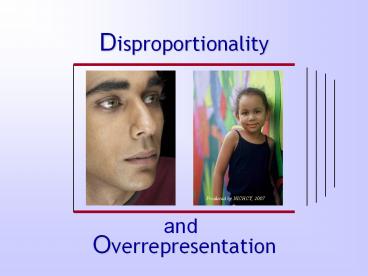Disproportionality - PowerPoint PPT Presentation
Title:
Disproportionality
Description:
Twice as likely as Whites and American Indians/ Alaskan natives to be identified ... Misidentification, misuse of tests. Lack of access to effective. instruction ... – PowerPoint PPT presentation
Number of Views:27
Avg rating:3.0/5.0
Title: Disproportionality
1
Disproportionality
Produced by NICHCY, 2007
and
Overrepresentation
2
This module looks at...
- Defining disproportionality
- Why disproportionality is on the front burner
- IDEA 2004s provisions
- Determination of significant disproportionality
- Resources for SEAs and LEAs
Produced by NICHCY, 2007
3
What is Disproportionality?
- of students of a specific ethnicity or race
Overrepresentation
In special education
In schools population
Produced by NICHCY, 2007
4
What is Disproportionality?
- of students of a specific ethnicity or race
Underrepresentation
In special education
In schools population
Produced by NICHCY, 2007
5
Statistics
- African-American childrenTwice as likely as
Whites and American Indians/ Alaskan natives to
be identified as having mental retardation. - African-American childrenHalf again more likely
than White students to be classified with
emotional disturbance.
Produced by NICHCY, 2007
6
Post-School Outcomes
- Unemployed 2 years out of high school
75 African-American students 47 White
Still not employed 3-5 years out of school
52 African-American young adults 39 White
young adults
40 African-Americans with disabilities 27
Whites with disabilities
Arrest rate
Produced by NICHCY, 2007
7
Why?
Some Hypotheses
- Failure of general education to educate children
from diverse backgrounds - Misidentification, misuse of tests
- Lack of access to effective instruction
- Insufficient resources
- Teachers who are less well prepared
- Poverty
Produced by NICHCY, 2007
8
What States Must Do
- 300.173
Produced by NICHCY, 2007
9
What States Must Do
- 300.646
Produced by NICHCY, 2007
10
Defining Significant Disproportionality
State defines for LEAs and for state in general
State determines criteria for what level of
disproportionality is significant
Produced by NICHCY, 2007
11
Determining Significant Disproportionality
Is based on collection and examination of data --
-- and not on a districts policies, procedures,
or practices.
Produced by NICHCY, 2007
12
How do you measure disproportionality?
Technical Assistance Guide fromU.S. Department
of Education
www.ideadata.org/docs/Disproportionality20Techni
cal20Assistance20Guide.pdf
Produced by NICHCY, 2007
13
What happens if theres a determination of
significant disproportionality?
Produced by NICHCY, 2007
14
For Determinations of Significant
Disproportionality
- States must
- Provide for the review and revision (if
appropriate) of policies, procedures, and
practices used in identification or placement of
children
Do they comply with requirements of IDEA?
Produced by NICHCY, 2007
15
For Determinations of Significant
Disproportionality
- States must
- Require LEAs to use 15 of Part B funds for
early intervening services
Produced by NICHCY, 2007
particularly, but not only, for children in
those groups significantly overidentified.
16
For Determinations of Significant
Disproportionality
- The LEA must
- Publicly report on the revision of policies,
practices, and procedures
Produced by NICHCY, 2007
17
IDEA 2004
- Disproportionality is now 1 of 3 monitoring
priorities.
- States must monitor LEAs levels of
disproportionality.
Produced by NICHCY, 2007
18
Reporting
- States must annually report under 6-year State
Performance Plan (SPP) on
of districts with DR of racial and ethnic groups
in special education and related services
that results from inappropriate identification
in specific disability categories
Produced by NICHCY, 2007
19
What Disability Categories?
mental retardation specific learning disabilities
emotional disturbance speech or language
impairments other health impairments autism
Produced by NICHCY, 2007
20
Sources of Technical Assistance
- IDEA authorizes and supports
- Technical assistance
- Demonstration projects
- Dissemination of information
- Implementation of scientifically based research
www.nccrest.org
Produced by NICHCY, 2007
21
NCCRESt Resources
www.nccrest.org
How-to guides.
- Data maps.
Practitioner briefs.
Produced by NICHCY, 2007
22
Questions?
Produced by NICHCY, 2007































